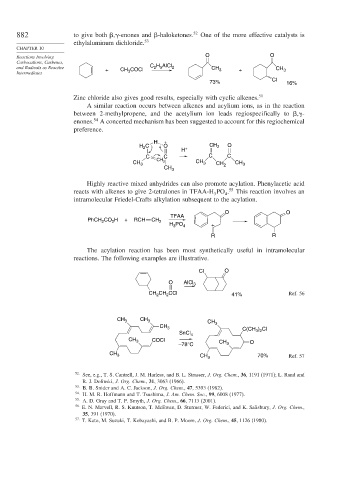Page 906 - Advanced Organic Chemistry Part B - Reactions & Synthesis
P. 906
882 to give both , -enones and -haloketones. 52 One of the more effective catalysts is
ethylaluminum dichloride. 53
CHAPTER 10
O O
Reactions Involving
Carbocations, Carbenes,
H AlCl
and Radicals as Reactive + CH COCl C 2 5 2 CH 3 + CH 3
Intermediates 3
Cl
73% 16%
Zinc chloride also gives good results, especially with cyclic alkenes. 51
A similar reaction occurs between alkenes and acylium ions, as in the reaction
between 2-methylpropene, and the acetylium ion leads regiospecifically to , -
54
enones. A concerted mechanism has been suggested to account for this regiochemical
preference.
H +
H C O CH 2 O
2
H +
C C C C
CH 3 CH 2 CH 3 CH 2 CH 3
CH 3
Highly reactive mixed anhydrides can also promote acylation. Phenylacetic acid
reacts with alkenes to give 2-tetralones in TFAA-H PO . 55 This reaction involves an
3 4
intramolecular Friedel-Crafts alkylation subsequent to the acylation.
O O
TFAA
PhCH CO H + RCH CH 2
2
2
H PO 4 +
3
R R
The acylation reaction has been most synthetically useful in intramolecular
reactions. The following examples are illustrative.
Cl O
O AlCl 3
CH CH CCl 41% Ref. 56
2
2
CH 3 CH 3 CH
CH 3 3 C(CH ) Cl
SnCl 4 3 2
CH 3 COCl CH
–78°C 3 O
CH 3 CH 3 70% Ref. 57
52 See, e.g., T. S. Cantrell, J. M. Harless, and B. L. Strasser, J. Org. Chem., 36, 1191 (1971); L. Rand and
R. J. Dolinski, J. Org. Chem., 31, 3063 (1966).
53
B. B. Snider and A. C. Jackson, J. Org. Chem., 47, 5393 (1982).
54
H. M. R. Hoffmann and T. Tsushima, J. Am. Chem. Soc., 99, 6008 (1977).
55 A. D. Gray and T. P. Smyth, J. Org. Chem., 66, 7113 (2001).
56 E. N. Marvell, R. S. Knutson, T. McEwen, D. Sturmer, W. Federici, and K. Salisbury, J. Org. Chem.,
35, 391 (1970).
57
T. Kato, M. Suzuki, T. Kobayashi, and B. P. Moore, J. Org. Chem., 45, 1126 (1980).

